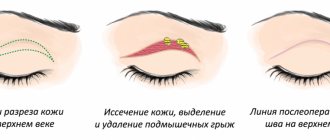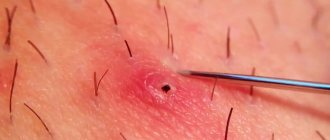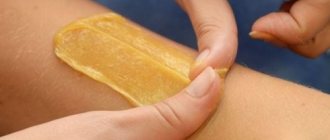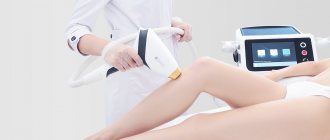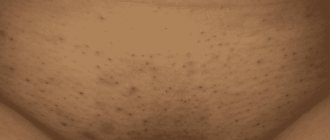Ingrown hairs
– ingrowth of the edge of the hair under the skin with the formation of a compaction of the area and possible further inflammation, scarring, and pigmentation. Almost always, the appearance of such hairs is accompanied by characteristic rounded red papules, similar to a rash ().
After depilation and some types of hair removal, the hair follicle is stimulated, active growth of the shaft begins, while it is thin, weak and cannot always break through the thickness of the dermis with a dense keratinized layer. Let's look at how you can remove ingrown hairs after hair removal - all available removal methods, as well as prevention methods ().
The first symptoms of ingrown hairs
The appearance of ingrown hairs after hair removal is very often accompanied by the following symptoms ():
- local itching in the area of epilation - as a rule, itching of visually clean areas;
- the appearance of papules - small hard formations;
- redness - caused by an inflammatory process;
- dry skin.
If itching appears, you should not comb the area - it has already received stress from the hair removal session, irritation can lead to a skin defect, the progression of inflammation - pseudofolliculitis. Take an antihistamine to relieve itching and apply a cool compress.
If the above symptoms appear, immediately contact a cosmetologist.
Inflamed areas can cause small wounds to appear; if infection gets into them, suppuration will intensify. The inflammatory process will affect the deep layers of the skin, the healing of which will proceed with the formation of scars or scars.
Unpleasant consequences and their treatment
After consultation with a specialist, he can prescribe medications that will help solve the problem of ingrown hairs. The list includes:
- Retinoids are creams that help eliminate dead cells. The product helps relieve hyperkeratosis and hyperpigmentation - darkened areas of the skin, which are very noticeable on dark-skinned people.
- Corticosteroids. An excellent mixture that helps control inflammation.
- Antibiotics. Antibiotic ointments can clear up the infection if there is one. In severe cases, oral antibiotics are prescribed for treatment.
Causes of ingrown hairs
Most often, ingrown hairs appear on the body after home hair removal. The problem occurs much less frequently among visitors to beauty salons.
Main reasons ():
- Dense layer of dermis. If the epidermis is covered with a dense layer of dead cells—the stratum corneum—then the skin becomes dense and hard. This is not a pathology, but renewed hairs cannot break through the thick layer of dermis. Hair weakened after hair removal cannot overcome thick skin on its own. The obstacle becomes insurmountable, a loop is formed and the inflammatory process begins.
- Thin, sensitive skin. An injured root causes the hair to begin to grow at an angle and, as a result, easily penetrates the dermis from the outside to the inside.
- Coarse hairs. It is impossible to change the structure of the rod; the most effective solution to the problem is laser hair removal. Targeting the hair follicle will help remove the ingrown hair.
Why is hair hard? The reason is genetic predisposition or hormonal background. These processes cannot be prevented; in other cases, the problem can be solved before it manifests itself.
Hair removal procedure at home
– this is the use of a traditional razor – use a new razor or blade at each session:
- the skin is softened with shaving foam or gel;
- hair is cut along the direction of growth;
- The depilation area is moisturized.
Don't get carried away with peeling - thinning skin causes ingrown hairs to appear. Peels should be soft, without using an aggressive scrub.
In the intimate area, ingrown hairs often appear due to tight underwear and poor hygiene of the area.
First signs
Problematic hair can appear at any time on any part of the body and face. Favorite places for ingrown hairs are the legs, pubic area, armpits, and in men, also the neck and face.
In other words, all areas where hair is frizzy and grows coarse.
An early sign of ingrown hair is hyperemia and swelling in the area where depilation is performed. After a couple of days, sometimes weeks, inflammation appears - painful, dense and itchy nodules. Sometimes you can see the dark tip of a hair through the skin. Did you know?
In ancient Egypt, every woman and every man shaved off their hair due to the heat. And at the ceremonies, which are depicted on the walls of the tombs, long black wigs were worn.
After the inflammatory process, post-inflammatory hyperpigmentation or scars sometimes remain in the affected area. Sometimes the hairs unfurl on their own and come out through the skin.
Ingrown vegetation requires diagnosis. Pseudofolliculitis is characterized by the appearance of problems on the skin with the beginning of constant depilation, and after changing the method or stopping depilation, the problem disappears.
The danger of ingrown hairs
Minor skin irritation and aesthetic problems are not all the consequences of ingrown hairs. Thick skin, the formation of tubercles, and the appearance of suppuration are symptoms of the body’s struggle with a foreign body. Hair growing under the dermis triggers mechanisms that provoke an increase in the number of leukocytes. An inflammatory process begins, which can lead to the formation of a wound. Bacteria can easily get into it. Lymph nodes are often located near the infected area - there are a large number of them in the groin and armpits. Pathogenic microorganisms can enter them and spread throughout the body.
Among the main consequences of late contact with specialists:
- active spread of infection;
- darkening of the skin in the inflamed area;
- the appearance of scars during the healing process;
- severe inflammation of the follicle.
The body fights these phenomena - the level of leukocytes increases, a temperature appears. In such a situation, it is urgent to consult a doctor, get treated and never allow such problems in the future.
Prevention
Prevention is necessary to prevent the problem from occurring at all. Before dealing with the unpleasant consequences of hair removal, you first need to change the method of hair removal itself. It is unreasonable to perform the same procedures, hoping for a different effect. Preventive measures are as follows:
- do light peeling before epilation;
- shave your skin with a machine exclusively according to hair growth (not vice versa);
- after depilation, soften the skin with a product that slows down the hair growth process;
- constantly treat delicate areas with a solution of salicylic acid, this gives an exfoliating effect;
- Immediately after epilation, you should not wear tight-fitting synthetic underwear - this can cause inflammation.
How to remove ingrown hairs
Competent and timely skin care reduces the likelihood of ingrown hairs to a minimum. What to do if you find a problem? It is necessary to relieve inflammation and remove the hair shaft ().
For this you will need:
- antibacterial wipes;
- medical alcohol;
- tweezers;
- needle.
Tools must be disinfected.
Removal of collected pus is carried out in the following order:
- antiseptic treatment of the inflammation zone;
- the free edge of the hair is brought out beyond the dermis, grabbed with tweezers, and removed;
- repeated antiseptic treatment;
- applying a bandage - its type is selected according to the situation; as a rule, simple or hydrogel-based antibacterial bandages are used.
If liquid of an unpleasant odor and color is released from the wound, then most likely it is purulent exudate.
Treatment of purulent wounds always involves surgical treatment, opening of the purulent cavity - all this is performed exclusively by a specialized specialist in a medical institution. The use of dressings for purulent wounds is possible both in medical institutions and at home. Dressings help fight infection and ensure the drainage of exudate from the wound ().
After epilation, carefully monitor the skin to detect a problem before the inflammatory process begins. Perform a gentle peeling - it will make the top layer of skin soft and the hair will easily break through and will be removed at the next hair removal session.
The master selects the necessary cosmetics, it is convenient for him to perform manipulations, and he takes into account the condition of the skin in the area of inflammation. Professional cleaning will help quickly eliminate skin problems and cope with the consequences of hair removal.
After hair removal, continue to closely monitor the inflamed area of skin. Simple remedies will help increase the rate of wound healing - cedar, orange or bergamot oil. After healing, spots may form at the site of the ingrown hair. This problem can be eliminated with the help of a folk remedy - bodyagi.
Eliminating Blue Spots
Quite often, after removing an ingrown hair, unsightly dark spots of a bluish or brown tint form in its place, and the bikini area takes on an unsightly appearance. This problem can be solved using pharmacy and home remedies.
Salicylic-zinc paste
The product has an effective whitening effect on the skin. Therefore, it can be used when skin pigmentation occurs after ingrown hairs. However, it is worth noting that salicylic-zinc paste has keratolytic properties, that is, it is able to soften and reject dead cells and hairs themselves.
To get rid of bruises, the drug should be applied daily to problem areas. The exposure time for the paste is 5–15 minutes. The procedure should be done within 5–6 days. Usually during this time the pigmentation should decrease.
Salicylic-zinc paste not only helps remove ingrown hairs, but also whitens the skin
Gel Badyaga 911
The drug is a remedy for bruises and contusions. It promotes rapid restoration of the skin and has an antiseptic and calming effect. In addition to badyagi, the product contains chamomile and horse chestnut extract, as well as essential oils of tea tree, juniper, mint, and arnica.
Gel Badyaga 911 is easy to use. It should be applied daily to dark spots before going to bed. The product is quickly absorbed without leaving greasy stains, so it does not need to be washed off. When applied, the gel cools and soothes the skin. The drug is recommended to be used for 5–7 days.
Whitening with peroxide
When hydrogen peroxide hits the skin, the oxygen molecules in its composition begin to oxidize melanin (the coloring pigment of the skin). As a result, melanin is destroyed and the skin becomes lighter.
To lighten dark spots, the skin must be lubricated several times a day with a cosmetic disc soaked in a solution of hydrogen peroxide.
Effect of fruit acids
Melanin is destroyed under the influence of an acidic environment. Therefore, lemon juice or apple cider vinegar is often used to whiten the skin.
To eliminate blue spots, it is recommended to use a composition containing the following ingredients:
- lemon juice or vinegar - 2 tsp;
- white clay - 1.5 tsp;
- tea tree essential oil - 3 drops.
Dilute the clay with lemon juice or apple cider vinegar to a paste and add tea tree oil. Apply the mixture to the stain and wash off after 20 minutes.
The proposed composition contributes not only to skin whitening, but also to its healing after removing an ingrown hair.
Parsley mask
Parsley also contains acids (ascorbic and nicotinic), which lighten the skin, and vitamin A helps quickly heal wounds and activates cellular restoration processes.
The whitening effect of parsley can be increased if its juice is combined with lemon and kefir juice, since these components are also known in cosmetology as skin whitening agents.
The whitening properties of parsley are often used in cosmetology.
Ingredients:
- parsley juice - 1 tsp;
- lemon juice - 1 tsp;
- kefir - 1 tsp.
Mix all ingredients and apply to problem areas. Rinse off the product after 20 minutes. You can use the mixture daily until the stains are completely removed.
After using whitening products, the skin must be soothed with moisturizer or Panthenol.
